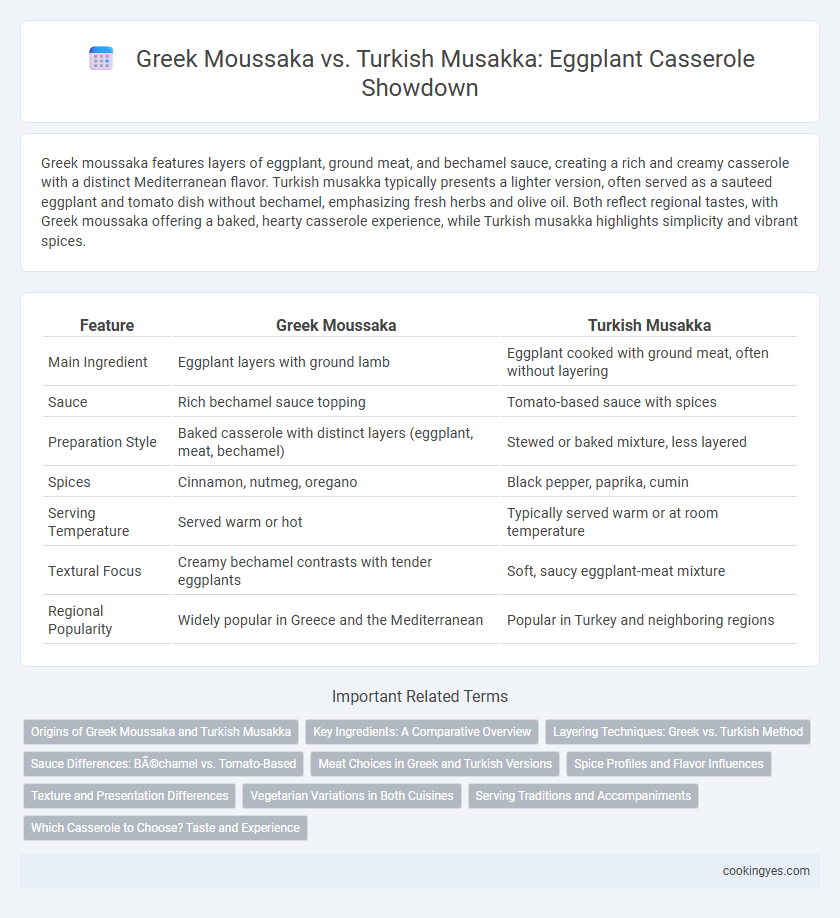Greek moussaka features layers of eggplant, ground meat, and bechamel sauce, creating a rich and creamy casserole with a distinct Mediterranean flavor. Turkish musakka typically presents a lighter version, often served as a sauteed eggplant and tomato dish without bechamel, emphasizing fresh herbs and olive oil. Both reflect regional tastes, with Greek moussaka offering a baked, hearty casserole experience, while Turkish musakka highlights simplicity and vibrant spices.
Table of Comparison
| Feature | Greek Moussaka | Turkish Musakka |
|---|---|---|
| Main Ingredient | Eggplant layers with ground lamb | Eggplant cooked with ground meat, often without layering |
| Sauce | Rich bechamel sauce topping | Tomato-based sauce with spices |
| Preparation Style | Baked casserole with distinct layers (eggplant, meat, bechamel) | Stewed or baked mixture, less layered |
| Spices | Cinnamon, nutmeg, oregano | Black pepper, paprika, cumin |
| Serving Temperature | Served warm or hot | Typically served warm or at room temperature |
| Textural Focus | Creamy bechamel contrasts with tender eggplants | Soft, saucy eggplant-meat mixture |
| Regional Popularity | Widely popular in Greece and the Mediterranean | Popular in Turkey and neighboring regions |
Origins of Greek Moussaka and Turkish Musakka
Greek Moussaka traces its origins to a blend of Ottoman culinary influences and traditional Mediterranean ingredients, evolving into a layered casserole featuring eggplant, minced meat, and bechamel sauce. Turkish Musakka, meanwhile, is more straightforward, typically prepared as a sauteed eggplant and tomato dish without layering, reflecting Ottoman roots including Levantine and Anatolian flavors. Both dishes highlight regional adaptations of eggplant casseroles, showcasing distinct approaches tied to Greece's Mediterranean heritage and Turkey's Anatolian cuisine.
Key Ingredients: A Comparative Overview
Greek moussaka features layers of eggplant, ground lamb, tomatoes, and a creamy bechamel sauce, emphasizing richness and depth of flavor. Turkish musakka, in contrast, typically incorporates sauteed eggplant with ground beef or lamb, tomatoes, onions, and often a lighter tomato-based sauce without bechamel. The Greek version uses pine nuts and cinnamon spices for complexity, while the Turkish variant favors simpler, rustic seasoning with garlic and parsley.
Layering Techniques: Greek vs. Turkish Method
Greek moussaka features distinct layers of fried eggplant, spiced ground meat, and bechamel sauce, creating a structured casserole with a creamy top. Turkish musakka involves mixing sauteed eggplant with tomatoes, peppers, and ground meat in a unified, stew-like preparation without separate layering. These differences in layering techniques highlight the Greek version's emphasis on textural contrast versus the Turkish approach's integrated flavor profile.
Sauce Differences: Béchamel vs. Tomato-Based
Greek moussaka features a rich bechamel sauce made from butter, flour, and milk, creating a creamy and velvety topping that contrasts with the layered eggplant and ground meat. In contrast, Turkish musakka uses a tomato-based sauce that infuses the casserole with a tangy, savory flavor, often incorporating garlic, onions, and spices such as paprika or cinnamon. The bechamel sauce in Greek moussaka adds a smooth, luxurious texture while the tomato sauce in Turkish musakka emphasizes a lighter, more acidic profile that enhances the dish's overall zestiness.
Meat Choices in Greek and Turkish Versions
Greek moussaka typically features ground lamb or beef layered with eggplant, potatoes, and a rich bechamel sauce, emphasizing a hearty and creamy texture. Turkish musakka often uses ground beef or lamb cooked with tomatoes, onions, and green peppers, served as a lighter, stew-like casserole without bechamel. The Greek version leans towards baked layers with a creamy top, while the Turkish dish focuses on a savory, saucy meat and vegetable combination.
Spice Profiles and Flavor Influences
Greek moussaka features a rich blend of cinnamon, nutmeg, and allspice, creating a warm, aromatic profile influenced by Ottoman spice trade history, paired with creamy bechamel sauce. Turkish musakka emphasizes simpler seasoning with ingredients like tomato, green peppers, and garlic, reflecting Mediterranean influences and a lighter, more vegetable-forward flavor. The contrast in spice profiles highlights Greek moussaka's complex layering versus Turkish musakka's fresh, tangy notes rooted in local produce and culinary traditions.
Texture and Presentation Differences
Greek moussaka features a layered structure with tender eggplant slices, ground meat, and a creamy bechamel sauce that creates a rich, smooth texture and a golden, baked top. Turkish musakka is typically a stew-like casserole with cubes of eggplant and vegetables cooked in a tomato-based sauce, resulting in a softer, saucier consistency without a baked crust. Presentation of Greek moussaka is more refined and firm, often served in slices, whereas Turkish musakka is spooned out more casually from a pot or dish.
Vegetarian Variations in Both Cuisines
Greek moussaka features layers of eggplant, potatoes, and a rich bechamel sauce, often adapted into vegetarian versions using lentils or mushrooms to replace meat. Turkish musakka typically consists of stewed eggplant with tomatoes, peppers, and onions, highlighting a naturally vegetarian-friendly preparation. Both cuisines emphasize eggplant's versatility, with Greek moussaka presenting a baked casserole style and Turkish musakka offering a saucier, sauteed dish, catering to plant-based diets through distinctive textures and flavors.
Serving Traditions and Accompaniments
Greek moussaka is traditionally served as a layered casserole featuring eggplant, minced meat, and bechamel sauce, often accompanied by a fresh Greek salad or crusty bread. Turkish musakka usually presents eggplants sauteed or baked with minced meat in a single-layer dish, commonly paired with pilaf or yogurt for a balanced meal. Serving practices emphasize Greece's rich, creamy textures and Turkey's lighter, spiced vegetable focus.
Which Casserole to Choose? Taste and Experience
Greek moussaka features layers of eggplant, ground lamb, and bechamel sauce, delivering a rich, creamy texture with Mediterranean spices, while Turkish musakka is a lighter, stewed eggplant dish with ground meat and tomato-based sauce offering a more savory and tangy flavor. Choosing between Greek moussaka and Turkish musakka depends on preference for either a baked, creamy casserole or a simmered, robustly flavored stew. For a traditional, indulgent experience, Greek moussaka excels; for a lighter, spiced eggplant dish with pronounced tomato notes, Turkish musakka is ideal.
Greek moussaka vs Turkish musakka for eggplant casserole Infographic

 cookingyes.com
cookingyes.com